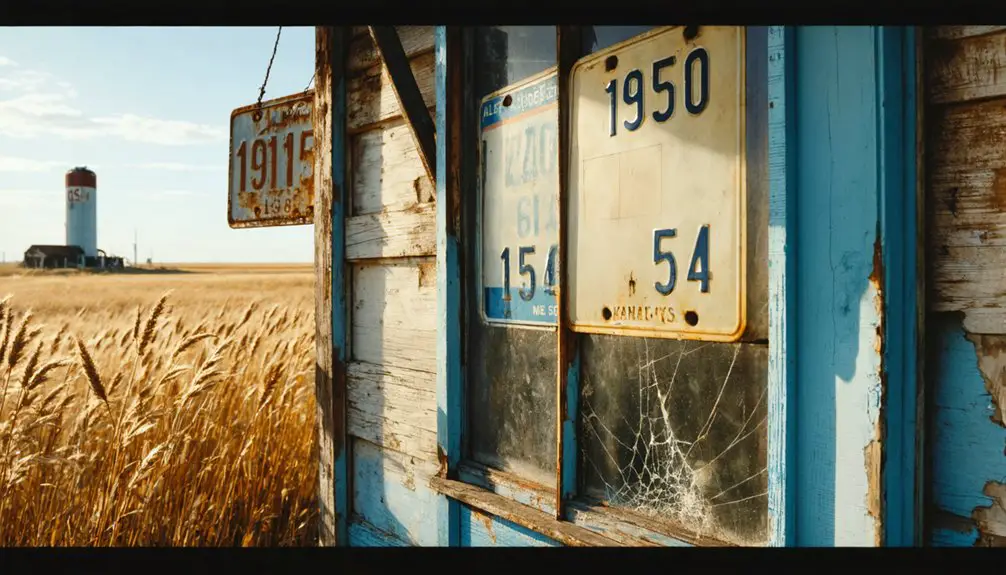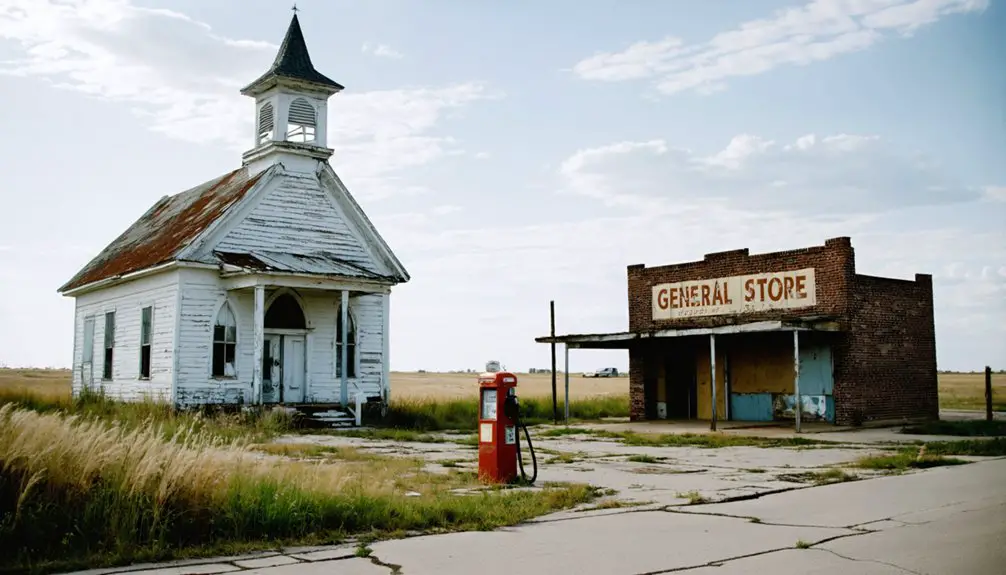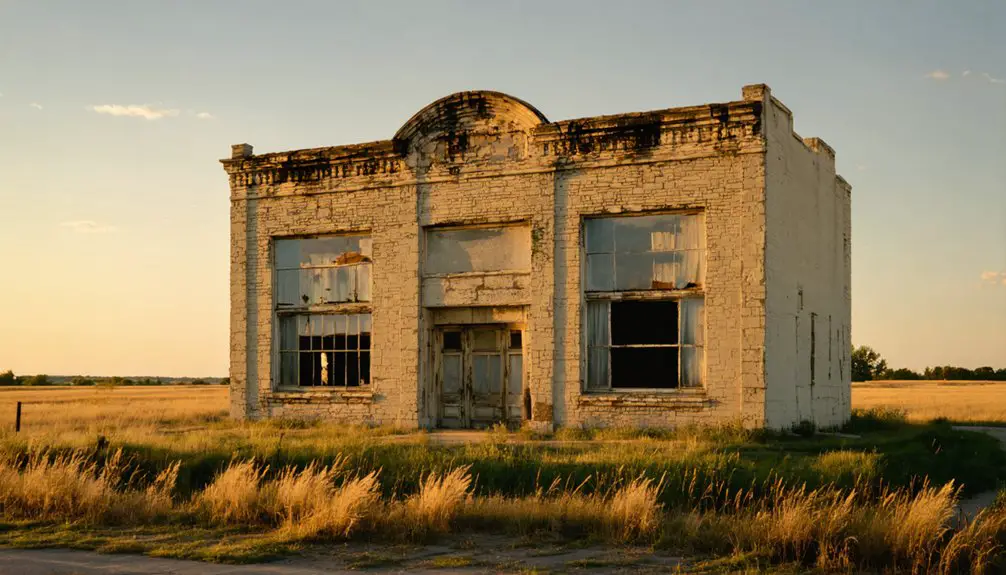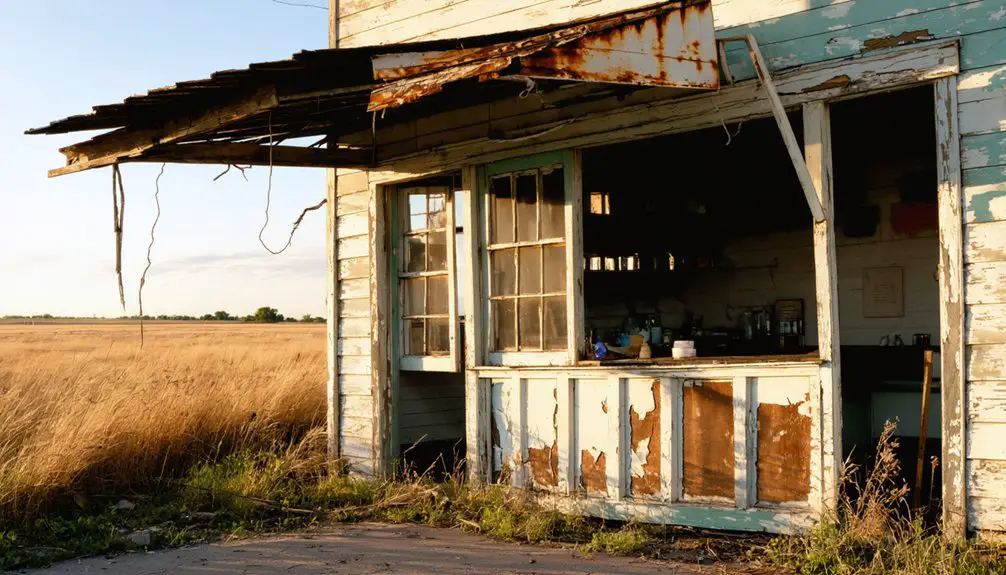You’ll discover Veteran, Kansas as a ghost town shaped by the rise and fall of Missouri River commerce. Originally home to the Kaw Nation, it flourished as a bustling trade post in the 1800s with steamboats carrying thousands of tons of freight. While flooding and bluff erosion challenged the town’s stability, it was ultimately the shift from river to rail transport that led to its abandonment. Today, stone ruins and the North Lyon County Veterans’ Memorial tell a deeper story of Kansas frontier life.
Key Takeaways
- Veteran was established as a bustling river trade town in Kansas, with roots in Native American territories and early European settlements.
- The town’s decline was primarily triggered by being bypassed by major transportation routes and the shift from river to railroad commerce.
- Natural challenges, including flooding and bluff erosion, contributed significantly to the town’s eventual abandonment.
- Today, Veteran exists as a ghost town with four main areas featuring business ruins, residential structures, high school remains, and memorials.
- Most structures are on private property with limited access, though the North Lyon County Veterans’ Memorial remains a notable landmark.
Early Native American Settlement and Trading Post Origins
Before European settlers arrived in Kansas Territory, the region was home to numerous Native American tribes, with the Kaw Nation (also known as the Kanza or “People of the Southwind”) maintaining a significant presence across present-day Kansas, Oklahoma, and Nebraska.
You’ll find that the Kaw people lived a nomadic lifestyle, following the seasonal buffalo migrations and using every part of the bison for food, tools, and materials.
The first documented European contact came in 1724 when French explorer Etienne Veniard de Bourgmont visited the Kaw.
The French established a profitable relationship with Native Americans as fur trappers and traders throughout the region during the following decades.
Following the Louisiana Purchase in 1803, trade relationships between French merchants and the Kaw Nation expanded significantly.
Rise of Steamboat Commerce Along the Missouri River
This trade expansion flourished rapidly – by 1841, you’d have seen twenty-six steamboats actively moving 46,000 tons of freight along the Lower Missouri.
If you’d booked passage, you’d have paid up to $300 for a journey that could last three months.
The 381-mile stretch between Kansas City and Sioux City became particularly busy, with vessels battling the “Big Muddy’s” treacherous currents and shifting sandbars.
Despite these challenges, steamboats proved essential in supporting frontier settlements and military outposts throughout the region. The summer operating months were critical for maximizing trips before the river froze over. Only one in four vessels successfully completed the challenging journey to Council Bluffs in 1819.
Daily Life in a River Town Community
You’d find Veteran’s bustling riverfront alive with traders hauling goods between steamboats and local mercantiles, while townspeople bartered for supplies and fresh catches from fishermen’s daily hauls.
Social gatherings centered around the town’s churches and schools, where families would meet for worship services, educational activities, and community celebrations. Daily life revolved around shared labor tasks as neighbors helped each other with farming, building, and livestock care.
The riverside location created natural meeting spots where residents shared news and conducted business, from simple daily transactions to larger commercial ventures that helped the town prosper. Early fur trading alliances between French merchants and local tribes helped establish the town’s position as a key commerce hub.
Riverfront Trade Activities
During the bustling era of riverfront trade in Kansas, daily life revolved around the steady flow of commerce along the state’s waterways.
You’d find traders establishing crucial trade routes at strategic points where they’d exchange furs and manufactured goods through well-established barter systems. If you’d visited a trading post, you’d have seen a mix of Native Americans and settlers conducting business, with goods moving both upstream and downstream. Quicksand and shallow waters made river navigation challenging.
Along these waterways, you’d pay about $1 to cross by ferry with your wagon, while steamboats like the Excel and Cherokee carried your freight between Kansas City and Fort Riley. Lightfoot of Quindaro was among the steamboats specially designed for the challenging river conditions.
During low water seasons, you’d need to switch to flatboats or keelboats, adapting to the river’s rhythms. The trading posts served as your fundamental hubs for supplies, news, and community gatherings.
Community Social Gatherings
Beyond the bustling trade activities, social gatherings formed the heartbeat of Veteran’s community life.
You’d find folks coming together in the community hall or schoolhouse for dances, church services, and seasonal festivals that strengthened social bonds. Local lodges hosted regular meetings, while traveling entertainers occasionally brought fresh entertainment to town.
Community traditions centered around mutual support, with neighbors helping each other during harvest time and barn-raisings. The town’s nineteen saloons provided numerous gathering spots for socializing and trading stories. Like nearby Junction City residents, locals enjoyed performances by Duke Ellington who played in the region.
You could join in Sunday services, prayer meetings, or catch up on local news at the saloon, which served as an informal community center.
Outdoor activities like fishing, picnics, and horse races kept everyone connected, while storytelling sessions and music, featuring folk songs and fiddle playing, brought entertainment to private homes and public gatherings alike.
Economic Foundations and Business Development
Like many frontier settlements of its era, Veteran’s economic foundation rested on a diverse mix of trading activities and specialized industries that served both indigenous groups and settlers.
You’d find essential tradespeople including physicians, blacksmiths, wagon makers, and gunsmiths who contributed to the town’s early economic impact. Local industries made use of natural resources, with sawmills processing timber and button manufacturers utilizing river mussel shells. Charcoal production helped meet regional energy needs.
The town’s business sustainability faced mounting challenges as agricultural modernization reduced labor requirements and population. When younger residents left for urban opportunities, remaining businesses struggled.
The arrival of big-box retailers within driving distance dealt another blow, while the lack of replacement industries accelerated the economic decline. Without a diverse commercial base, Veteran’s once-thriving economy gradually faded away.
Transportation Evolution’s Impact on Town Survival

While railroad development initially transformed Veteran into a bustling frontier town, the evolution of transportation networks ultimately sealed its fate.
Like many Kansas settlements, you’ll find that Veteran’s story reflects the broader transportation changes that reshaped the American frontier. When railroads dictated commerce patterns, towns lived or died by their proximity to the tracks. You can trace Veteran’s decline to the rise of highways and automobiles, which dramatically altered how people moved and traded goods.
These town changes weren’t unique to Veteran – they repeated across Kansas as transportation patterns evolved. When highways bypassed these once-thriving rail stops, residents could suddenly drive to larger trade centers for goods and services.
The improved mobility that originally built these towns ironically contributed to their abandonment.
Natural Challenges and Environmental Factors
When you look at Veteran’s history, you’ll find that its proximity to nearby waterways brought both benefits and significant risks to the settlement.
The town’s location made it vulnerable to periodic flooding from regional rivers, which repeatedly damaged local infrastructure and discouraged permanent settlement.
Erosion of the surrounding bluffs also posed an ongoing threat to the town’s stability, as soil movement and degradation undermined building foundations and agricultural efforts.
River Flooding Impact
Throughout the mid-20th century, devastating floods along Kansas rivers wreaked havoc on numerous settlements, including Veteran. You’ll find that these communities, built near riverbanks and floodplains, faced recurring devastation as waterways swelled to more than a mile wide, submerging buildings under several feet of water.
The Great Flood of 1951 proved particularly catastrophic, destroying essential infrastructure and severing economic lifelines.
While modern flood mitigation strategies now help protect Kansas towns through dams and reservoirs, these measures came too late for places like Veteran. The town’s vulnerability to repeated flooding, combined with its proximity to meandering rivers and challenging soil composition, made recovery increasingly difficult.
Today, ghost town preservation efforts document how these natural disasters transformed once-thriving communities into abandoned remnants of the past.
Bluff Erosion Problems
Beyond the river flooding that sealed Veteran’s fate, the town’s position near unstable bluffs created additional challenges for its survival.
You’ll find the bluff stability was constantly threatened by a perfect storm of natural forces. When groundwater seeped through permeable soil layers and became trapped behind less permeable ones, it created dangerous conditions for landslides.
The freeze-thaw cycles you’d experience in Kansas winters made things worse, as ice formation expanded in soil cracks and weakened the bluff structure.
Without proper erosion control measures, the loss of deep-rooted vegetation exposed soil to wind and rain damage.
The bluffs’ mixed composition of silt, sand, and gravel, combined with these environmental stressors, meant residents faced an ongoing battle against nature’s relentless forces.
The Exodus: Why Residents Left

As railroads began crisscrossing Kansas in the late 19th century, Veteran’s fate was sealed by its unfortunate location away from major transport routes.
Without economic diversification, the town couldn’t sustain itself when steamboat traffic declined on the Missouri River. You’d have seen the town’s community resilience tested as essential services disappeared one by one – the general store, blacksmith shop, and eventually the post office.
The mechanization of farming dealt another blow, as fewer workers were needed to manage larger farms.
Young people left for urban opportunities, while those who remained watched their town slowly fade.
Natural disasters, particularly flooding and erosion along the river, only hastened the exodus.
When the schools and churches finally closed, the heart of the community stopped beating.
What Remains Today: A Walking Tour
Four distinct areas await visitors exploring Veteran’s ghost town today: scattered business ruins along Main Street, deteriorating residential structures, a dangerously unstable brick high school, and several well-maintained veterans’ memorials.
As you walk through this cultural heritage site, you’ll spot old bank vaults with their combination locks still intact, and stone building shells that hint at the town’s former prosperity.
While most structures are on private property, you can observe these historical landmarks from public areas and roadsides.
The North Lyon County Veterans’ Memorial offers a poignant glimpse into local military history through its benches and stone markers.
Due to safety concerns and legal restrictions, you’ll want to keep your exploration to exterior viewing – especially around the hazardous high school building.
Legacy of River Towns in Kansas History

While Veteran’s physical remnants tell one story of Kansas history, the state’s river towns paint an even broader picture of its development.
You’ll find that these settlements, established along the Missouri and Kansas Rivers in the early 1800s, became the backbone of Kansas’s economic and social evolution. The rich indigenous heritage of the Kanza people intertwined with French fur traders, creating vibrant cultural interactions that shaped early commerce.
You can trace how these river towns connected essential routes like the Santa Fe Trail, fostering trade and westward migration. During the tumultuous Bleeding Kansas period, these settlements became strategic strongholds, while their marketplaces and steamboat traffic drove regional growth.
The legacy lives on in places where railways later complemented river transport, transforming frontier outposts into thriving communities.
Frequently Asked Questions
What Was the Peak Population of Veteran During Its Most Prosperous Years?
You’ll find that population trends show Veteran peaked at 190 residents in 1920, driven by economic factors like local stores and mills, before declining as business activity diminished in the region.
Were There Any Notable Crimes or Lawlessness Incidents in Veteran’s History?
You won’t find records of notable crime incidents or law enforcement challenges in Veteran’s past. Unlike some infamous Kansas frontier towns, there’s no documented history of significant lawlessness here.
What Happened to the Original Land Deeds of Veteran’s Properties?
You’ll find most original land deeds were lost or destroyed due to poor record-keeping, while others became void when owners abandoned their claims. Many deed transfers went unrecorded during the town’s rapid decline.
Did Any Famous Historical Figures Ever Visit or Pass Through Veteran?
Of 2,000+ documented Kansas ghost towns, many lack visitor records. You won’t find proof of any famous visitors or historical figures passing through Veteran – its brief history remains largely anonymous and undocumented.
Were There Any Attempts to Revive or Preserve Veteran as a Historic Site?
You won’t find any records of historic preservation efforts or community involvement aimed at reviving Veteran. The ghost town’s limited remaining structures and lack of local support have left it largely forgotten.
References
- https://www.legendsofamerica.com/doniphan-kansas/
- https://dianastaresinicdeane.wordpress.com/2012/01/29/columbia-a-kansas-ghost-town-story/
- http://www.kansasheritage.org/werner/gostnmco.html
- https://legendsofkansas.com/kansas-ghost-town-list/
- https://en.wikipedia.org/wiki/List_of_ghost_towns_in_Kansas
- https://en.wikipedia.org/wiki/History_of_Kansas
- https://www.visittopeka.com/blog/post/native-american-heritage-month-the-story-of-the-kaw-and-pappans-ferry/
- https://keep.konza.k-state.edu/handbookdocuments/Early Kansas Settlement – 2012.pdf
- https://legendsofkansas.com/indian-territory-in-kansas/
- https://www.kawnation.gov/history-of-kaw-nation/



